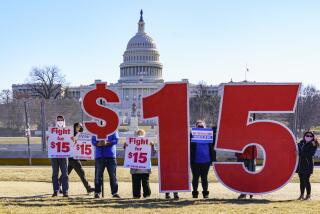Poverty Rate Drops to Lowest Since 1980
- Share via
WASHINGTON — The percentage of Americans living below the poverty line dropped last year to the lowest level since 1980, the Census Bureau reported Thursday. It shrank from 14% in 1985 to 13.6%.
But although it dropped for the third year in a row, the poverty rate remained well above the levels of the 1970s. And, the new figures disclosed, the income of the poor fell further behind the income of the rest of the country, widening the gap between haves and have nots.
There was no significant change in the number of Americans living in poverty, the Census Bureau said. It estimated the number at 32.4 million last year compared with 33.1 million in 1985. The income at which the poverty level is set varies by family size; for a family of four it was $11,203 last year.
Family Income Grows
While the poor made only modest gains last year, the average American family enjoyed one of the largest increases in real income in the last 15 years as median family income rose 4.2% to $29,460. When adjusted for inflation, the median family income remained below the peaks of $29,734 in 1973 and $29,647 in 1978, but it is finally likely to surpass those levels this year, the Census Bureau said.
Real median family income--the point that divides the top half of all family incomes from the lower half--has risen 10.7% since 1982, when the country was in the midst of one of its worst recessions of the last 40 years.
Continuing a recent trend, the gap between the most affluent and the poorest Americans reached its widest point in decades. The top 20% of all households, which represented those with incomes above $45,980, collected 46.1% of all household income, an increase from 44.2% in 1980 and 43.3% in 1970. Meanwhile, the lowest 20%--those with incomes below $10,250, collected just 3.8%, a decrease from 4.1% in both 1970 and 1980.
“There has been an increase in income inequality in the United States in the last decade and a half,” said Gordon W. Green Jr., chief of the Census Bureau’s Poverty and Wealth Statistics Branch.
The reasons behind the growing income disparity are complex, Green said, explaining that the large influx of young baby-boom workers in recent years has caused a reduction in pay for entry-level jobs. The growth of single-parent families has also lowered income for those hit by divorce, death and separation. Conversely, the rise in two-earner families has increased the money flowing to higher-income groups.
Found Among Broken Homes
The new statistics showed that poverty had become even more concentrated among broken families, and that 51% of all the poor families consisted of households headed by an unmarried woman. While the number of two-parent families below the poverty line fell to 3.1 million, the number of poor households where no husband is present increased slightly to 3.6 million.
Advocates for the poor were disturbed by what they said were indications that improving economic conditions do not appear to be as helpful in lifting families out of poverty as in the past. The poverty rate in 1986, when the unemployment rate averaged 7%, remained significantly higher than in 1977, when unemployment averaged a similar 7.1%.
“What is disturbing here is that poverty has remained so high four years into an economic recovery,” said Robert Greenstein, director of the Center on Budget and Policy Priorities.
President Reagan, however, issued a statement that the figures “demonstrate once again that sustained, non-inflationary growth is the government’s single best tool for fighting poverty and building a better life for our nation’s families.”
In fact, the percentage of Americans living in poverty has dropped faster during this expansion than during the economic recovery of the late 1970s.
About 9 million blacks remained in poverty last year, nearly one-third of all blacks in the United States. Among whites, 22.2 million--or 11% of the total--were below the poverty line. There were 5.1 million poor Latinos, and their poverty rate was 27.3%, a 1.7 percentage point decline from the previous year.
More to Read
Get the L.A. Times Politics newsletter
Deeply reported insights into legislation, politics and policy from Sacramento, Washington and beyond. In your inbox twice per week.
You may occasionally receive promotional content from the Los Angeles Times.










